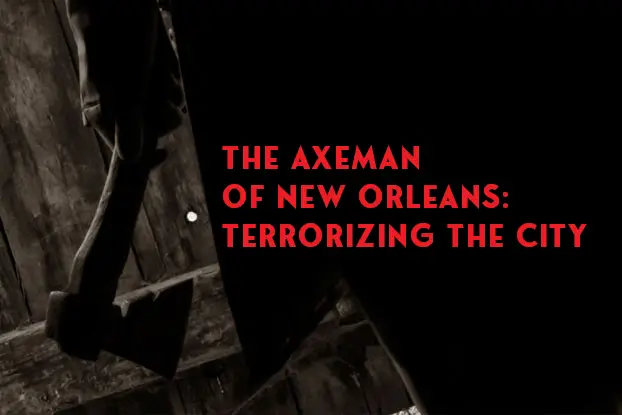Table of Contents
In the early 20th century, a mysterious serial killer terrorized the city of New Orleans. Known as the Axeman of New Orleans, this killer was responsible for the brutal murders of at least six people between 1918 and 1919. Despite a massive police investigation and numerous suspects, the Axeman was never caught, and his true identity remains a mystery to this day.
Background Information
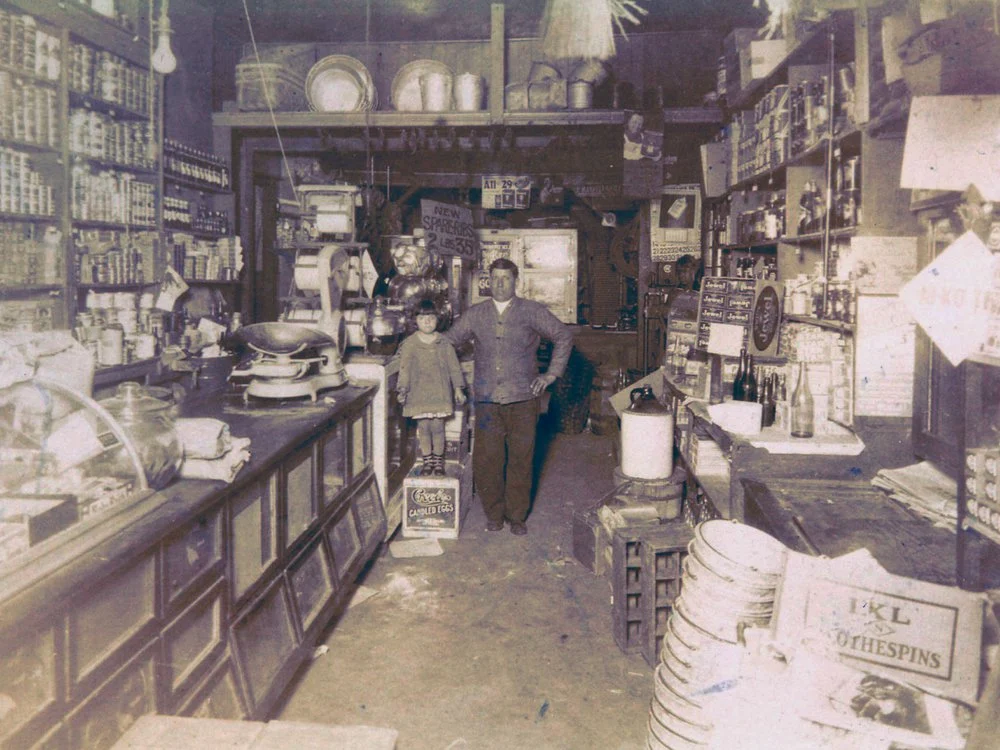
During the Axeman’s reign of terror, New Orleans was a bustling port city with a diverse population of immigrants, including many Italian-Americans. The killer’s victims were also primarily Italian-Americans, leading to speculation that the Axeman may have had some kind of vendetta against the community.
The Axeman was known for using an ax or straight razor to carry out his murders, and he would often target couples in their own homes while they slept. The killer’s methods were brutal, and his crimes struck fear into the hearts of residents throughout the city.
Preview of Main Points
In this article, we will explore the story of the Axeman of New Orleans in greater detail. We will examine the historical context of the killer’s crimes and investigate the murders themselves, as well as the police investigation that followed. We will also delve into the mysterious letter that the Axeman supposedly wrote to the local newspaper, and examine the impact that his crimes had on the city of New Orleans and the wider world.
Historical Context
The Social and Political Climate of New Orleans in the Early 20th Century
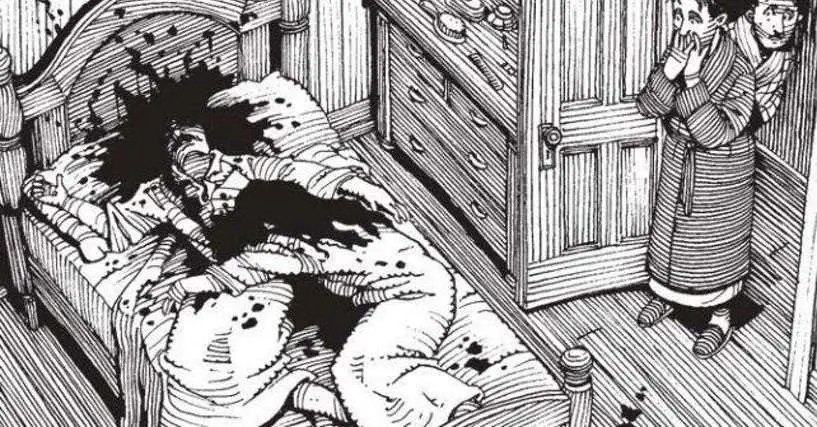
To understand the impact of the Axeman’s crimes, it is important to first examine the social and political climate of New Orleans during the early 20th century. During this time, the city was a hub of commerce and industry, attracting immigrants from all over the world who were seeking new opportunities and a better life.
However, this influx of new residents also created tension and conflict, particularly between different ethnic and racial groups. Italian-Americans in particular were often discriminated against and viewed with suspicion, as they were seen as outsiders who were unwilling to assimilate into American culture.
At the same time, the city’s political landscape was dominated by corrupt officials and powerful businessmen who controlled much of the city’s wealth and resources. This created a climate of distrust and disillusionment among many residents, who felt that the government was not serving their interests.
The Axeman’s Crimes in Context
Against this backdrop of social and political unrest, the Axeman’s crimes took on a heightened significance. The fact that the killer primarily targeted Italian-Americans was seen as evidence of a larger pattern of discrimination and prejudice within the city.
Furthermore, the brutality of the Axeman’s murders seemed to reflect a growing sense of lawlessness and chaos that was pervading New Orleans at the time. The fact that the killer was able to evade capture for so long despite a massive police effort only served to reinforce the idea that the city was a dangerous and unstable place.
Overall, the Axeman’s crimes must be understood within the larger context of New Orleans in the early 20th century, as they were both a symptom of and a response to the social and political tensions that were present in the city at the time.
The Murders
The Axeman is believed to have committed at least six murders between 1918 and 1919. Here is a closer look at each of the known victims:
Victim Profiles
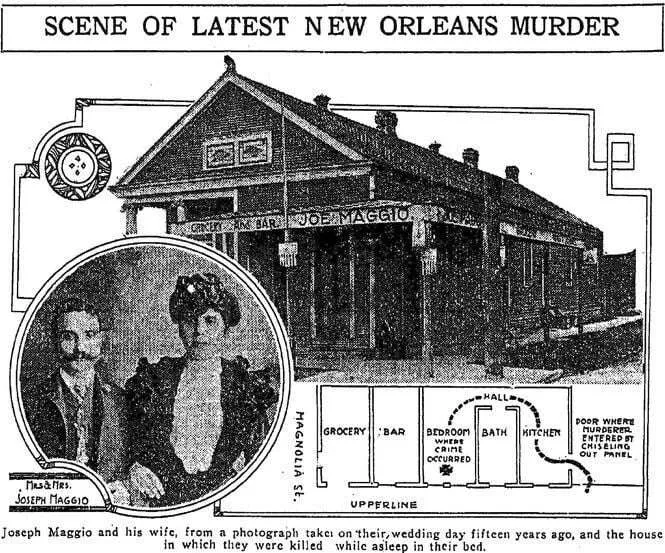
- Joseph Maggio and his wife Catherine were attacked in their home on May 22, 1918. Both were brutally assaulted with an ax, and Catherine died from her injuries.
- Louis Besumer and his mistress Harriet Lowe were attacked in their home on June 27, 1918. Besumer died from his injuries, while Lowe survived.
- Anna Schneider was attacked in her home on August 5, 1918. She was severely injured but survived.
- Joseph Romano was attacked in his home on March 10, 1919. He died from his injuries.
- Charles Cortimiglia was attacked in his home on March 10, 1919. He died from his injuries.
- Rosie Cortimiglia, Charles’ wife, was attacked in their home on May 3, 1919. She was severely injured but survived.
Murder Weapons
The Axeman is believed to have used an ax or straight razor in all of his attacks. In some cases, the weapon was found at the scene of the crime, while in others it was never recovered.
Modus Operandi and Motivations
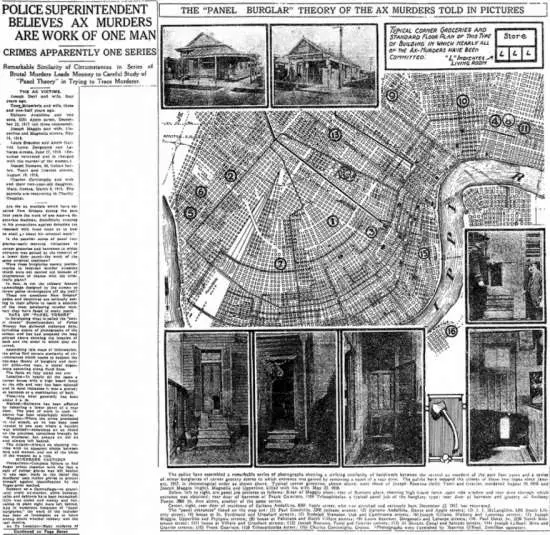
The Axeman’s modus operandi was characterized by a brutal and violent approach to his victims. He would often target couples while they slept in their homes, using his weapon of choice to bludgeon or slash them to death.
Despite extensive investigation by the police, the Axeman’s motivations remain unclear. Some have speculated that he may have been motivated by a desire for revenge against the Italian-American community, while others have suggested that he may have been a mentally unstable individual seeking to exert power and control over his victims.
Overall, the Axeman’s murders were marked by a sense of fear and chaos that gripped the city of New Orleans during this time period. The fact that the killer was able to strike repeatedly and avoid capture only added to the sense of unease and uncertainty that pervaded the community.
Investigation and Suspects
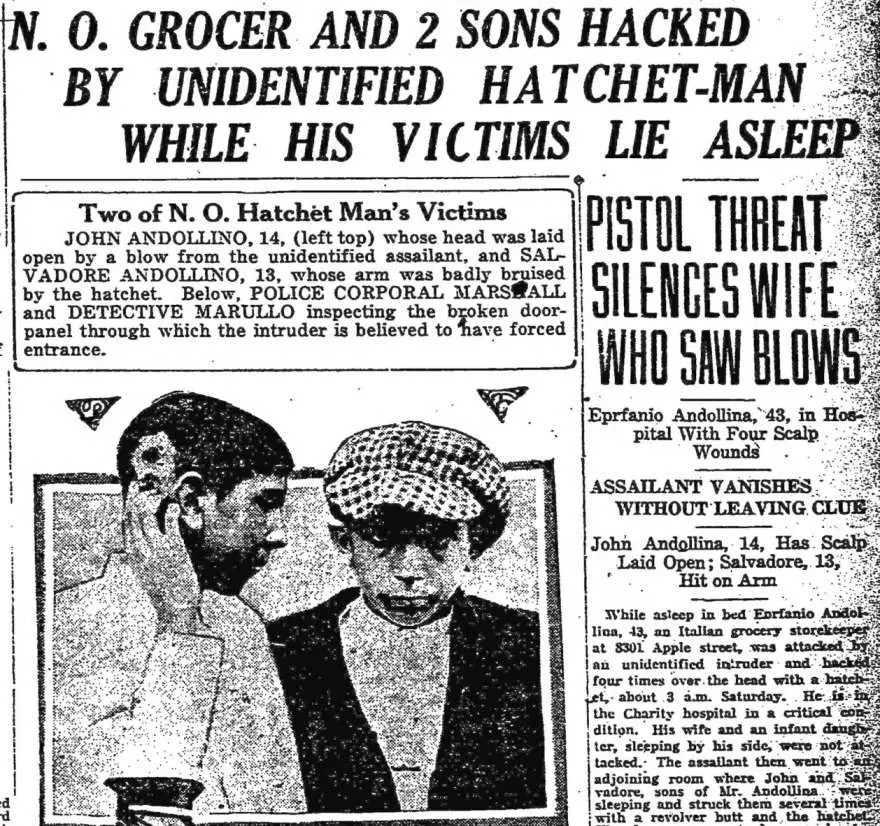
Despite an extensive investigation, the Axeman was never caught. Here is a closer look at the police investigation and some of the key suspects:
Police Investigation
The investigation into the Axeman’s crimes was one of the largest and most intensive in the history of New Orleans. Police officers worked around the clock to track down leads and gather evidence, but their efforts were hampered by a lack of forensic technology and a dearth of reliable eyewitnesses.
In an attempt to lure the killer out of hiding, the police commissioner even wrote a letter to the local newspaper, urging the Axeman to strike again on a certain night. However, the killer never took the bait.
Key Suspects
There were several suspects who were investigated by the police during the course of the Axeman’s crime spree. Here are some of the most notable:
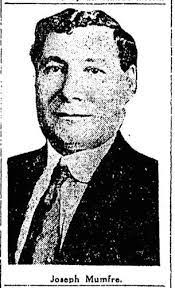
- Joseph Mumfre: Also known as “The Phantom,” Mumfre was a known criminal and bootlegger who was believed to have connections to the Italian-American community. He was arrested and charged with one of the murders, but was eventually released due to lack of evidence.
- Frank Gento: Gento was a local grocer who had been feuding with the victim of one of the Axeman’s attacks. He was arrested and charged with the crime, but was later released after new evidence emerged.
- Mike Pepitone: Pepitone was a barber who had been attacked by the Axeman in his own home. He survived the attack, but was later implicated as a suspect due to his suspicious behavior and alleged involvement in illegal activities.
Despite these and other leads, the police were never able to definitively identify the Axeman or bring him to justice. To this day, the identity of the killer remains a mystery.
The Axeman’s Letter
One of the most chilling aspects of the Axeman’s crime spree was a letter that was purportedly written by the killer and sent to the local newspaper. Here is a closer look at this infamous letter:
The Letter
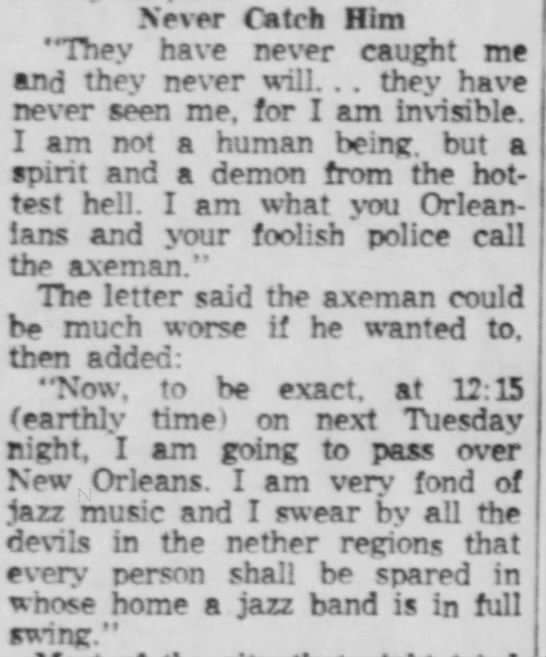
The letter was published in the New Orleans Times-Picayune on March 13, 1919, and was addressed to the editor of the newspaper. In the letter, the Axeman claimed responsibility for the recent murders and threatened to strike again:
“Hottest Hell awaits for ye who continue to be deaf to the words of the Mighty and Omnipotent Jazz! […] I am very fond of jazz music, and I swear by all the devils in the nether regions that every person shall be spared in whose home a jazz band is in full swing at the time I have just mentioned. If everyone has a jazz band going, well, then, so much the better for you people. One thing is certain and that is that some of your people who do not jazz it out on that specific Tuesday night (if there be any) will get the axe.”
The letter was signed “The Axeman.”
Analysis
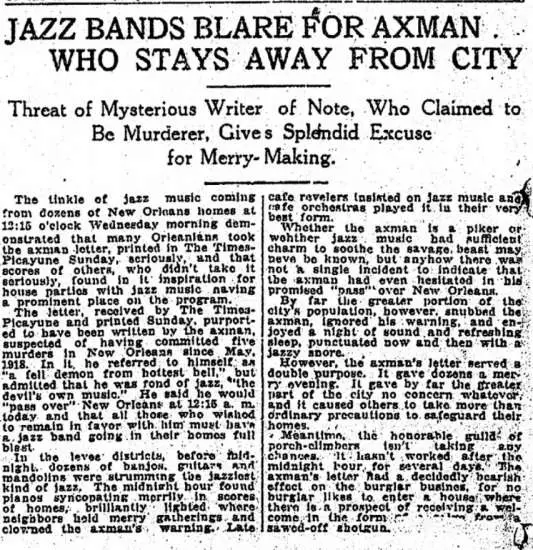
The letter is notable for several reasons. Firstly, it reveals that the killer had a penchant for jazz music, which he seemed to believe held some sort of mystical power. Additionally, the letter is written in a boastful and taunting tone, suggesting that the Axeman took pleasure in the fear and panic that he was causing in the community.
Some experts have suggested that the letter may have been a hoax, designed to throw off the police or to drum up publicity for the newspaper. However, the fact that the letter accurately predicted the date of the next murder (which did in fact take place on a Tuesday) lends some credibility to its authenticity.
Overall, the Axeman’s letter serves as a haunting reminder of the killer’s twisted mindset and the terror that he inflicted upon the people of New Orleans.
Legacy and Influence
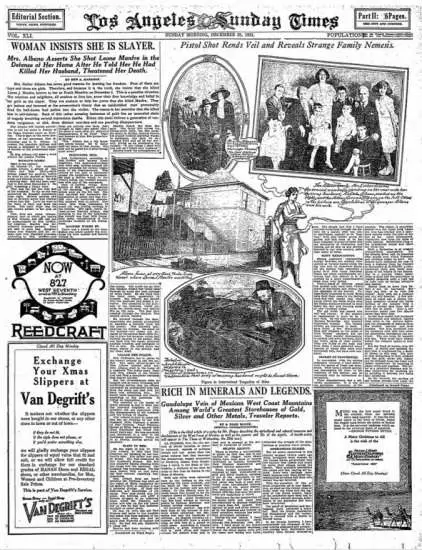
The Axeman’s crimes had a lasting impact on the city of New Orleans and the wider world. The case remains one of the most notorious unsolved serial killings in history and has inspired countless books, movies, and TV shows.
Cultural Legacy
The Axeman’s story has been referenced in various popular media and music. For example, in 1919, a composer named Joseph John Davilla wrote a song called “The Mysterious Axman’s Jazz (Don’t Scare Me Papa),” which was supposedly played by many jazz bands in the city on the night of the supposed final Axeman killing. Additionally, the story has been featured in episodes of TV shows such as “American Horror Story” and “Criminal Minds,” as well as in numerous books and articles.
Continuing Fascination
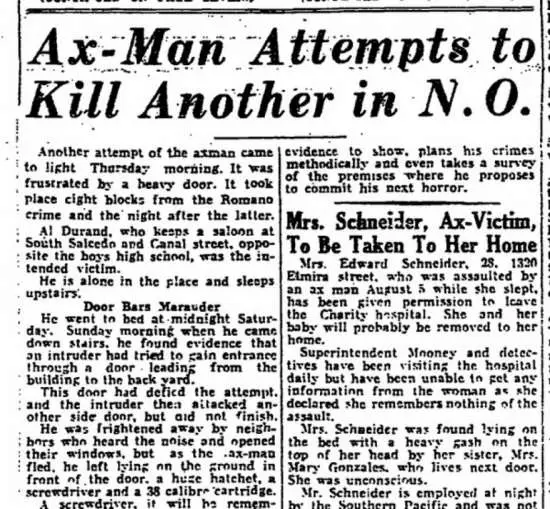
The Axeman of New Orleans case continues to fascinate people today because of its gruesome nature and the fact that the killer was never caught. Despite numerous suspects and theories over the years, the true identity of the Axeman remains a mystery. The case has also sparked discussions about the social and political climate of New Orleans during the early 20th century, and how it may have contributed to the killer’s actions.
Conclusion
In conclusion, the Axeman of New Orleans was a terrifying figure who struck fear into the hearts of New Orleans residents during the early 20th century. His crimes were brutal and senseless, and his true identity remains a mystery to this day. The legacy of the Axeman lives on in popular culture and serves as a reminder of the darkest aspects of human nature.
Related: Strange Myths & Facts of Doctor Mary S. Sherman’s Unsolved Murder

